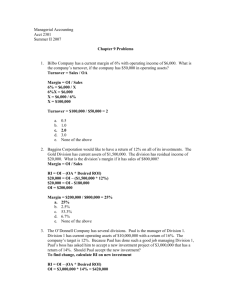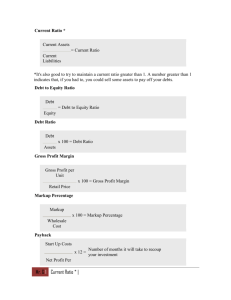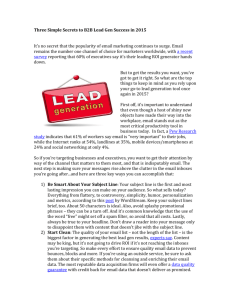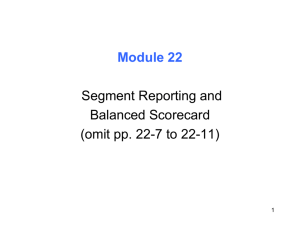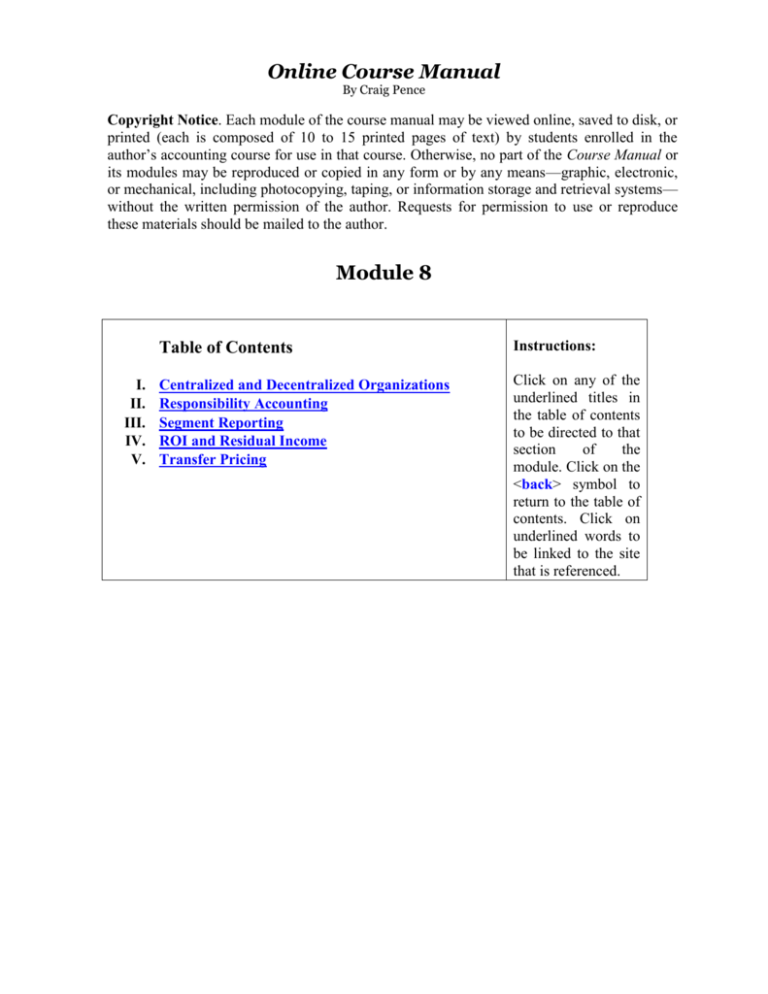
Online Course Manual
By Craig Pence
Copyright Notice. Each module of the course manual may be viewed online, saved to disk, or
printed (each is composed of 10 to 15 printed pages of text) by students enrolled in the
author’s accounting course for use in that course. Otherwise, no part of the Course Manual or
its modules may be reproduced or copied in any form or by any means—graphic, electronic,
or mechanical, including photocopying, taping, or information storage and retrieval systems—
without the written permission of the author. Requests for permission to use or reproduce
these materials should be mailed to the author.
Module 8
I.
II.
III.
IV.
V.
Table of Contents
Instructions:
Centralized and Decentralized Organizations
Responsibility Accounting
Segment Reporting
ROI and Residual Income
Transfer Pricing
Click on any of the
underlined titles in
the table of contents
to be directed to that
section
of
the
module. Click on the
<back> symbol to
return to the table of
contents. Click on
underlined words to
be linked to the site
that is referenced.
Managerial Accounting Course Manual
2
Module 8 Summary
I.
Centralized and Decentralized Organizational Structure. The business
firm’s organizational structure (the way the organization is “structured” as regards which
people are given authority to make decisions) may be either centralized or decentralized.
A.
Centralized organizations are characterized by “top-down” management. Decisionmaking power is concentrated in the hands of relatively few people in the
organizations (i.e., those at the “top”). In decentralized organizations decisions are
made by persons at all levels within the organization. Only the smallest of
organizations can rely on just one or a few people to make operating decisions, so
most are decentralized to one extent or another.
B.
C.
Advantages of Decentralization.
1.
Top management is free to focus on the “big picture,” setting goals and
planning strategies without having to worry about details and minor
problems.
2.
All persons in the organization participate in the management of the
business. This improves morale, provides training for mid-managers who
may someday move into top-management positions, keeps employees
informed and involved in the business, and provides a basis for the
evaluation of the abilities of managers at all levels in the organization.
Disadvantages of Decentralization.
1.
Decisions made by many different decision-makers may be poorly
coordinated and may not conform to the company’s overall goals and
strategies. This can occur because lower-level managers are not fully aware
of the company’s broad strategies or because of “empire-building” within
individual departments.
2.
New ideas may not be acted upon as quickly since a consensus of opinion
must be reached regarding their adoption.
<back>
II.
Responsibility Accounting (also called profitability accounting) pertains to an
accounting system that accumulates and reports information for each responsibility center
that the company wishes to evaluate and control.
A.
A responsibility center may be a cost center (the managers of the center are only
responsible for costs in the center), a profit center (costs and revenues are both
generated in the center and the center's management is responsible for them), or an
investment center (a profit center in which the managers are also responsible for
decisions regarding the purchase and sale of assets within the center).
B.
Only the costs and revenues that the responsibility center's managers are
responsible for (called the controllable costs and revenues) are listed in the center's
©201 Craig M. Pence. All rights reserved.
3
Managerial Accounting Course Manual
evaluation reports. Recall from Module 1 that the corporate organization chart is a
graphical representation of the positions of responsibility in the corporation.
1.
At the uppermost levels of the corporation's organization chart, all costs,
revenues and investments are listed, since managers at this level are
responsible for everything that occurs within the entire company.
2.
As reports are prepared for other responsibility centers further down the
organization chart, fewer and fewer of the costs, revenues, and investments
appear since lower-level managers are not responsible for as many of them.
C.
III.
Service Departments have the role of providing services to operating departments.
While operating departments are directly involved in producing the organization's
goods or services, service departments indirectly participate in this primary activity
through their support of the operating departments. A "Painting Department,"
where the final finish is applied directly to the company's product is an example of
an operating department. The Accounting, Personnel, Janitorial and Maintenance
Departments are examples of service departments.
1.
Since operating departments benefit from the services that service
departments provide, the costs of operating the service departments must be
charged to the operating departments and included with their other
departmental costs. This must be done in order to (1) properly evaluate the
performance of the operating departments and (2) to fully cost the goods
and services they produce.
2.
The process of assigning these costs to the operating departments and to
production is referred to as service department cost allocation. This is
usually done in two steps:
a.
Assign the service department costs to the operating departments
using an appropriate activity base. The resulting application rates are
called service department charge rates.
b.
Apply these costs along with the operating department costs to the
goods and services produced.
<back>
Segments and Segment Reports. Since decisions are made by several decisionmakers in decentralized organizations, ways must be found to evaluate decisions and the
managers who make them. Decentralized organizations do this by dividing the operation
into individual segments for which records are kept. Segment reports may then be prepared
for evaluation purposes.
A.
Segment Reporting. As we know, cost centers, profit centers, and investment
centers are all called responsibility centers. Reports must be prepared for the
organization’s responsibility centers so they can be analyzed and evaluated.
1.
Segments may be defined in many different ways with reports prepared
accordingly. For example, individual production department reports may be
prepared, product-line reports may be created, or reports may be prepared
©2012 Craig M. Pence. All rights reserved.
Managerial Accounting Course Manual
4
for individual work cells. The company would probably prepare all three
sets of reports and others as well for use in managing overall operations.
2.
3.
Contribution margin format income statements are often prepared for profit
and investment centers. Recall that contribution margin statements follow
the format shown below:
Sales Revenue
$X
Variable Costs
(X)
Contribution Margin
$X
Fixed Costs
(X)
Net Income
$X
The income statement or cost report prepared for a segment should list only
those costs for which the segment manager is responsible. This means that
only the segment’s variable costs and its traceable fixed costs should appear
on the segment report and be used to determine the segment’s income from
operations.
<back>
IV.
ROI and Residual Income. Segment margin does measure the profitability of the
segment and can be used to evaluate the manager’s performance, but the use of absolute
numbers can be misleading. For example, you would probably be impressed to hear that
one of your friends earned a return of $10,000 in the stock market last year; but if you then
found out that the return was earned on a $1,000,000 investment (a 1% rate of return) your
opinion regarding your friend’s success would probably change. The point here is that
relative comparisons (the 1% rate of return is a measure of profit relative to investment) are
more meaningful than absolute values (the $10,000 profit).
A.
ROI (Return on Investment) is a relative measure of performance that calculates
the rate of return earned by the segment. The segment’s net operating income
(earnings before interest and taxes, called EBIT) is divided by the average level of
assets invested in the segment to calculate a rate of return:
ROI = Income from Operations ÷ Average Operating Assets
1.
Note that use of the ROI provides the same kind of relative performance
measure as the rate of return earned on the stock investment described
earlier. Operating income, an absolute value, is not an adequate
performance measure. The asset investment required to produce the income
must also be factored into the evaluation, and ROI provides for this.
2.
EBIT is used instead of total segment margin in order to factor out nonoperating revenues and expenses (such as interest revenue or expense, gains
©201 Craig M. Pence. All rights reserved.
5
Managerial Accounting Course Manual
or losses on asset sales, etc.). This is done because it is segment operating
performance that is being evaluated. Non-operating items distort the report
and can result in faulty evaluations.
3.
B.
For the same reason, only operating assets (those used directly to support
operations) are used in calculating ROI. Non-operating assets are short-term
investments or other assets not used in operations. Some companies use the
full original cost of the assets in the formula; but most companies (and the
text) use the book values of the operating assets (i.e., original cost less
accumulated depreciation).
Usefulness of ROI as a Performance Measure. It is helpful to look “inside” ROI
to understand its real strengths and weaknesses as a performance measure.
1.
ROI can be viewed as a composite ratio, one that is formed from two other
ratios – a “profit margin” ratio and a “turnover” ratio:
Profit Margin Ratio =
Investment Turnover Ratio =
Net Operating Income
Sales
Sales
Average Operating Assets
a.
The meaning of the margin ratio is clear. If a margin ratio of 10% is
calculated, then ten cents of operating income is produced from
every dollar of sales. The other ninety cents was lost to COGS and
operating expenses. A company with a high margin ratio is getting a
lot of profit “bang” from each “buck” of sales. If the company
wants to increase its margin, it must increase sales (without
increasing expenses proportionately), decrease expenses (without
reducing sales proportionately), or do both.
b.
The meaning of the turnover ratio is less obvious. If the turnover
ratio is 2, then the company can generate $2 of sales for every $1
invested in assets. A company with a high turnover ratio relative to
other companies in its industry is “lean and mean.” The company is
using its assets efficiently, generating a large amount of sales
revenue from them. Because it is able to keep its asset investment
low while still producing adequate sales revenue, its expenses
(maintenance, depreciation, insurance, property taxes) will be
reduced and its profits will compare favorably with other companies
in the industry.
©2012 Craig M. Pence. All rights reserved.
Managerial Accounting Course Manual
2.
ROI =
Note that ROI could be expressed as follows:
Operating Income
Operating Assets
=
Operating Income
Sales
ROI = Profit Margin Ratio
3.
6
X
Sales
Operating Assets
X Turnover Ratio
This relationship (originated by the DuPont Corporation) provides insight
into the meaning of ROI. How can ROI be increased? If the margin ratio
rises (by improving profitability and/or reducing average assets), or if
turnover increases (by increasing sales and/or decreasing assets), then ROI
will grow. A company that invests in unproductive assets will have a poor
turnover ratio and will probably have a low ROI. Likewise, a company that
is not able to mark up its products by very much will have a poor profit
margin ratio and also have a low ROI. Heaven help the company that has
older, inefficient assets and an unpopular product with low demand.
<back>
C.
Residual Income is related to ROI, and is another measure through which
managers may be evaluated. To calculate residual income, the minimum required
rate of return (the rate of return the company wants to earn on its investment in the
assets used by the segment) must be known.
1.
The minimum required rate of return is multiplied by the average operating
assets (as defined in the section on ROI above) invested in the segment. The
result represents the EBIT that the segment should produce in order to
produce an ROI that is equal to the company’s minimum required rate of
return.
Average Operating Assets
x Minimum Required Rate Return
= Minimum Required Dollar Amount Return
2.
The result of this multiplication, the minimum required EBIT return in
dollars, is then subtracted from the segment margin to calculate residual
income, the income that is left over (the residue) after the required return is
provided.
Segment Income from Operations
- Minimum Required Dollar Amount Return
= Residual Income
©201 Craig M. Pence. All rights reserved.
7
Managerial Accounting Course Manual
The greater the segment’s residual income, the better the job done by its
management.
3.
The residual income evaluation method encourages managers to take
advantage of any opportunity to earn rates of return greater than the
company’s overall required rate of return. If ROI is the only measure used,
managers are reluctant to enter into any business transaction that does not
provide a rate of return that is at least as large as the ROI earned by the
segment on the previous performance report. To do so would only result in
a new ROI that is lower the last figure, and reflects poorly on the segment.
This is illustrated in the example below.
<back>
You may click the link below to play a video that walks you through the
solution to the sample problem below.
Link to ROI and Residual Income Illustration
ROI and Residual Income Example:
ROI: The Carpet Installation Department of Greson’s Carpet Company is accounted for as an
investment center, with ROI used as the evaluation measure. Last year’s performance report for the
company was as follows:
Department
Installation
Sales
Total
Revenue
$ 15,000
$ 45,000
$ 60,000
Variable Costs
(10,000)
(20,000)
(30,000)
Fixed Costs
(2,000)
(12,000)
(14,000)
Operating Income
$ 3,000
$ 13,000
$ 16,000
Operating Assets
$15,000
$39,000
$54,000
20%
33%
29.6%
ROI
Suppose the Installation Department manager is considering the purchase of carpet laying
equipment that would cost $5,000. The use of the equipment will produce variable cost savings of
$1,000 but will increase fixed costs by $250. The net result is $750 in savings per year. Since the
©2012 Craig M. Pence. All rights reserved.
Managerial Accounting Course Manual
8
equipment costs $5,000, the rate of return earned on an investment in this equipment is 15% ($750
÷ $5,000). Assume that the company requires a rate of return of 8% on any asset investments that it
makes. If this is the case, the carpet laying equipment would be a good investment. However, if the
Installation Department manager does buy the equipment, the department’s performance will now
be as follows (the numbers in italics are those that have changed):
Example, Continued
Installation
Department
Revenue
$ 15,000
Variable Costs
(9,000)
Fixed Costs
(2,250)
Operating Income
$ 3,750
Operating Assets
$20,000
ROI
18.8%
Since the manager does not like to see the ROI earned by the department fall from the previous
year’s level, he or she may well decide not to purchase the equipment. This is not, however, in the
company’s best interest.
Residual Income:
Suppose a residual income evaluation measure is used instead of ROI. Given the 8% required rate
of return for the company, the original performance report would appear as follows:
Department
Installation
Sales
Total
Revenue
$ 15,000
$ 45,000
$ 60,000
Variable Costs
(10,000)
(20,000)
(30,000)
Fixed Costs
(2,000)
(12,000)
(14,000)
Operating Income
$ 3,000
$ 13,000
$ 16,000
Operating Assets
$15,000
$39,000
x 8%
x 8%
Required Income
$1,200
$ 3,120
*
$1,800
$9,880
Required ROI
Residual Income
*
= Operating Income – Required Income
©201 Craig M. Pence. All rights reserved.
9
Managerial Accounting Course Manual
If the Installation Department manager does purchase the equipment, the department’s
performance report would now appear as follows:
Installation
Department
Revenue
$ 15,000
Variable Costs
(9,000)
Fixed Costs
(2,250)
Operating Income
$ 3,750
Operating Assets
$20,000
Required ROI
x 8%
Required Income
$1,600
Residual Income
$2,150
Since the residual income increases as a result of the purchase, the manager is free to acquire the
equipment. This ensures the selection of assets by managers that will benefit the company, even if
they produce declines in the ROI for the segment.
<back>
V.
Transfer Pricing is concerned with the determination of the "price" at which units are
transferred among departments within the company, and not with the price at which the
product is sold to the customer.
A.
The problem of assigning transfer prices to departments is important since, in a
decentralized organization, the individual cost centers, profit centers and investment
centers are held responsible for the costs incurred and revenues earned within the
centers.
B.
The determination of the transfer price (i.e., the "price" at which units are
transferred into other centers) directly affects the center's costs and/or revenues.
1.
To illustrate this, consider the following scenario. You are the manager of
the Bolt Department in your company, and you manufacture the bolts used
to make your company's product. It currently costs $.02 to make a bolt in
your department. An outside supplier of bolts will sell bolts to your
company for $.01 each, and another manufacturer is willing to buy bolts
from your company for $.03 each. Suppose management has decided not to
purchase the bolts from the outside supplier and not to sell the bolts to the
other manufacturer, but rather to continue to use your bolts in the Assembly
©2012 Craig M. Pence. All rights reserved.
Managerial Accounting Course Manual
C.
10
Department. How should the bolts be "priced" when they are sent to the
Assembly Department?
2.
You would prefer that they be priced at $.03 since this will improve your
department's profits, but this will increase the Assembly Department's costs
and reduce its profit. The Assembly Department manager would prefer to
use $.01, but this will reduce your revenues and your department's profit.
Deciding upon a fair transfer price is both important and difficult to do.
Two general approaches are used to set transfer prices:
1.
Cost-based methods establish a price based upon the cost of producing the
item. Under a cost-price approach, the cost of producing the item becomes
the transfer price; under a cost-plus approach the cost is increased by a
profit percentage that is negotiated between the managers of the affected
departments. In the illustration above, if a 10% profit percentage is agreed
upon, the bolts would be priced at $.022 [$.02 + ($.02 x 10%)].
2.
Market transfer prices are represented by either (1) the price that would be
paid if the units were purchased from outside suppliers or (2) the price that
would be received if they were sold to parties outside the firm. In the
example above, where a single market price cannot be determined, the
method cannot be applied directly - though both the $.01 purchase price and
the $.03 sales price would likely enter into the determination of a transfer
price.
3.
Under either of the two approaches it is important that the managers of the
cost centers affected be involved in the determination of the transfer price,
and in either case it is preferable that the transfer price used be a negotiated
transfer price (i.e., determined by bargaining between the managers).
<back>
-END-
©201 Craig M. Pence. All rights reserved.

